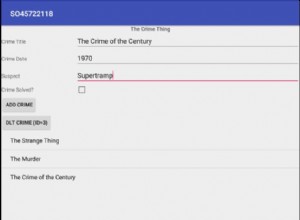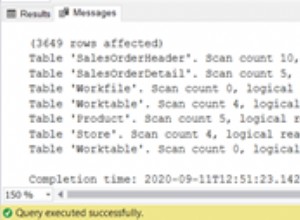Kiedy zacząłem odpowiadać na to pytanie, pomyślałem, że będzie to szybkie i łatwe, ponieważ kiedyś zrobiłem coś bardzo podobnego w SQL Server, ale udowodnienie koncepcji tłumaczenia przerodziło się w to pełne rozwiązanie.
Jedynym zastrzeżeniem, które nie było jasne z twojego pytania, jest to, czy masz warunek zadeklarowania identyfikatora podstawowego w porównaniu z identyfikatorem aliasu. Na przykład to rozwiązanie pozwoli 1 mieć alias 4, a 4 mieć alias 1, co jest zgodne z danymi dostarczonymi w uproszczonym przykładowym pytaniu.
Aby skonfigurować dane dla tego przykładu, użyłem następującej struktury:
CREATE TABLE notnormal_customers (
id INT NOT NULL PRIMARY KEY,
aliases VARCHAR(10)
);
INSERT INTO notnormal_customers (id,aliases)
VALUES
(1,'|4|58|76'),
(2,''),
(3,''),
(4,'|1|58|76'),
(58,'|1|4|76'),
(76,'|1|4|58');
Po pierwsze, aby przedstawić relację jeden-do-wielu dla jednego klienta do wielu aliasów, utworzyłem następującą tabelę:
CREATE TABLE customer_aliases (
primary_id INT NOT NULL,
alias_id INT NOT NULL,
FOREIGN KEY (primary_id) REFERENCES notnormal_customers(id),
FOREIGN KEY (alias_id) REFERENCES notnormal_customers(id),
/* clustered primary key prevents duplicates */
PRIMARY KEY (primary_id,alias_id)
)
Co najważniejsze, użyjemy niestandardowego SPLIT_STR funkcja
:
CREATE FUNCTION SPLIT_STR(
x VARCHAR(255),
delim VARCHAR(12),
pos INT
)
RETURNS VARCHAR(255)
RETURN REPLACE(SUBSTRING(SUBSTRING_INDEX(x, delim, pos),
LENGTH(SUBSTRING_INDEX(x, delim, pos -1)) + 1),
delim, '');
Następnie utworzymy procedurę składowaną, która wykona całą pracę. Kod jest opatrzony komentarzami do odnośników źródłowych.
DELIMITER $$
CREATE PROCEDURE normalize_customers()
BEGIN
DECLARE cust_id INT DEFAULT 0;
DECLARE al_id INT UNSIGNED DEFAULT 0;
DECLARE alias_str VARCHAR(10) DEFAULT '';
/* set the value of the string delimiter */
DECLARE string_delim CHAR(1) DEFAULT '|';
DECLARE count_aliases INT DEFAULT 0;
DECLARE i INT DEFAULT 1;
/*
use cursor to iterate through all customer records
http://burnignorance.com/mysql-tips/how-to-loop-through-a-result-set-in-mysql-strored-procedure/
*/
DECLARE done INT DEFAULT 0;
DECLARE cur CURSOR FOR
SELECT `id`, `aliases`
FROM `notnormal_customers`;
DECLARE CONTINUE HANDLER FOR NOT FOUND SET done = 1;
OPEN cur;
read_loop: LOOP
/*
Fetch one record from CURSOR and set to customer id and alias string.
If not found then `done` will be set to 1 by continue handler.
*/
FETCH cur INTO cust_id, alias_str;
IF done THEN
/* If done set to 1 then exit the loop, else continue. */
LEAVE read_loop;
END IF;
/* skip to next record if no aliases */
IF alias_str = '' THEN
ITERATE read_loop;
END IF;
/*
get number of aliases
https://pisceansheart.wordpress.com/2008/04/15/count-occurrence-of-character-in-a-string-using-mysql/
*/
SET count_aliases = LENGTH(alias_str) - LENGTH(REPLACE(alias_str, string_delim, ''));
/* strip off the first pipe to make it compatible with our SPLIT_STR function */
SET alias_str = SUBSTR(alias_str, 2);
/*
iterate and get each alias from custom split string function
https://stackoverflow.com/questions/18304857/split-delimited-string-value-into-rows
*/
WHILE i <= count_aliases DO
/* get the next alias id */
SET al_id = CAST(SPLIT_STR(alias_str, string_delim, i) AS UNSIGNED);
/* REPLACE existing values instead of insert to prevent errors on primary key */
REPLACE INTO customer_aliases (primary_id,alias_id) VALUES (cust_id,al_id);
SET i = i+1;
END WHILE;
SET i = 1;
END LOOP;
CLOSE cur;
END$$
DELIMITER ;
Na koniec możesz go po prostu uruchomić, dzwoniąc:
CALL normalize_customers();
Następnie możesz sprawdzić dane w konsoli:
mysql> select * from customer_aliases;
+------------+----------+
| primary_id | alias_id |
+------------+----------+
| 4 | 1 |
| 58 | 1 |
| 76 | 1 |
| 1 | 4 |
| 58 | 4 |
| 76 | 4 |
| 1 | 58 |
| 4 | 58 |
| 76 | 58 |
| 1 | 76 |
| 4 | 76 |
| 58 | 76 |
+------------+----------+
12 rows in set (0.00 sec)




